Introduction
The Carenado Cirrus SR22 GTSx Turbo is another release in the
Carenado HD Series for FSX/P3D. Carenado have built their
reputation with a solid background in producing aircraft from
the traditional stables of Beechcraft, Cessna, and Piper general
aviation aircraft, and more recently, single and multi engine
aircraft in the civil utility / light business / executive
transport role. So, the Cirrus SR22 is Carenado's first foray
into producing a composite construction aircraft.
If there was ever a high end, luxury, touring saloon aircraft
category in the four seat class, the Cirrus SR22 GTSx Turbo
would sit very comfortable in such a category. The SR22 GTSx
oozes class, and luxury, with fine lines and a beautiful
appearance. Carenado and a reputation for quality are synonymous
and they are continually pushing the boundaries with every new
release. Again, Carenado have lived up to this reputation with
high quality and exceptional detail in the Cirrus SR22 GTSx
Turbo.
History
The Cirrus SR22 GTSx Turbo is a four seat, single engine, modern
high performance, general aviation aircraft of composite
construction. It is a low wing, cantilever monoplane with a non
retracting, tricycle landing gear. The landing gear has a
castering nose wheel with ground steering via differential
braking on the main wheels. Developed from the Cirrus SR20, the
SR22 has a more powerful engine, larger wing, and higher fuel
capacity and is probably best known for being equipped with the
Cirrus Airframe Parachute System (CAPS).
The SR22 entered production in 2001 and has consistently been
one of the best selling aircraft in its class. Improvements made
over the course of production have included, airframe
modifications, fuselage, wing, and landing gear changes, and an
increase in take-off weight. A full glass cockpit was introduced
in 2003, with an improved glass cockpit introduced in 2008 as
standard equipment. A turbocharged option was introduced in
2006, with a larger turbocharged engine variant, the SR22T,
being offered from 2010.
Availability and Installation
The Cirrus SR22 GTSx Turbo is currently available direct from
Carenado and Carenado resellers as a 'download only' product
(some resellers also offer a master back-up CD service for a
minor additional cost). Some of the Carenado range are
subsequently being published as 'boxed media' so the SR22 may be
available in this format in the future. In 'download only'
format, it is priced at US$34.95, or the equivalent on currency
cross rates. The file size of 82.9MB is very reasonable for an
aircraft of this type and quality and it requires 380MB of HDD
space for installation. Depending on where it was purchased, a
‘key code’ may be issued to be used during installation.
There are two models provided (one pilot and two pilots), five
HD paint schemes and a HD blank texture provided for aircraft
painting enthusiasts.
Documents
There are five manuals / documents provided in Adobe Acrobat
format (.pdf):
● Carenado G1000 Perspective Users Guide – this 25 page manual
details the operation of the G1000 primary flight display (PFD),
Multi function display (MFD), and GFC 700 Control Unit;
● Normal Procedures – this 11 page manual provides the
procedures for the normal operation of the aircraft;
● Emergency Procedures – this 10 page manual provides the
procedures for the emergency operation of the aircraft;
● Performance Tables – this three page document details the
operating cruise performance specifications of the aircraft;
● Reference Table – this one page document details the
performance specifications of the aircraft; and
● Recommended Settings – this two page document details
recommended settings for Display and Realism for Carenado
aircraft.
Model Features
With payware add-on aircraft, you will sometimes find the
developer / publisher compromising by focusing on a higher level
of accuracy or detail in one aspect of the aircraft at the
expense of others. It might be the flight model versus the
visual model or an extremely detailed 'procedural' cockpit with
full FMC capability versus the visual model. This is not the
case with Carenado's SR22. If you want to get the most out of
flying the SR22 and fully immerse yourself in the experience,
then read the manual. Sure, you can strap yourself straight in
and take to the skies in the SR22, but chances are, you will
miss some of the finer detail and experiences to be had,
particularly with the features of the G1000 Perspective. This
review has involved over 25 hours of specific review and flight
testing flying time and I am still discovering aspects of
functionality each time I fly this beautiful aircraft. The
Carenado G1000 Perspective Users Guide is a "must read" at some
point.
The standard model features listed by Carenado for the Cirrus
SR22 GTSx Turbo are typical of models in the Carenado range and
includes:
● HD quality textures (2048 x 2048);
● 3D gauges;
● Instrument reflections;
● Original HQ digital stereo sounds recorded directly from the
real aircraft;
● Realistic flight dynamics and weight and balance; and
● Tested by real world SR22 pilots during various phases of
flight, such as: take-off, climb, cruise, descend, approach,
landing and
specific manoeuvres.
In addition, and this is an area that Carenado focus a lot of
effort, are the special model features, which include:
● Carenado Garmin 1000 Perspective PFD and MFD, with GFC 700
Control Unit;
● Window lighting scratches effect (crazing);
● Dynamic propeller shine effect;
● Lighting rendering system, with landing, taxi, strobe and
beacon lights illuminating objects and the ground;
● 3D stereo sounds; and
● Knobs and switch sounds.
Other visual features and the texture mapping effects introduced
in FSX Service Pack 2 are also included.
Paint Schemes
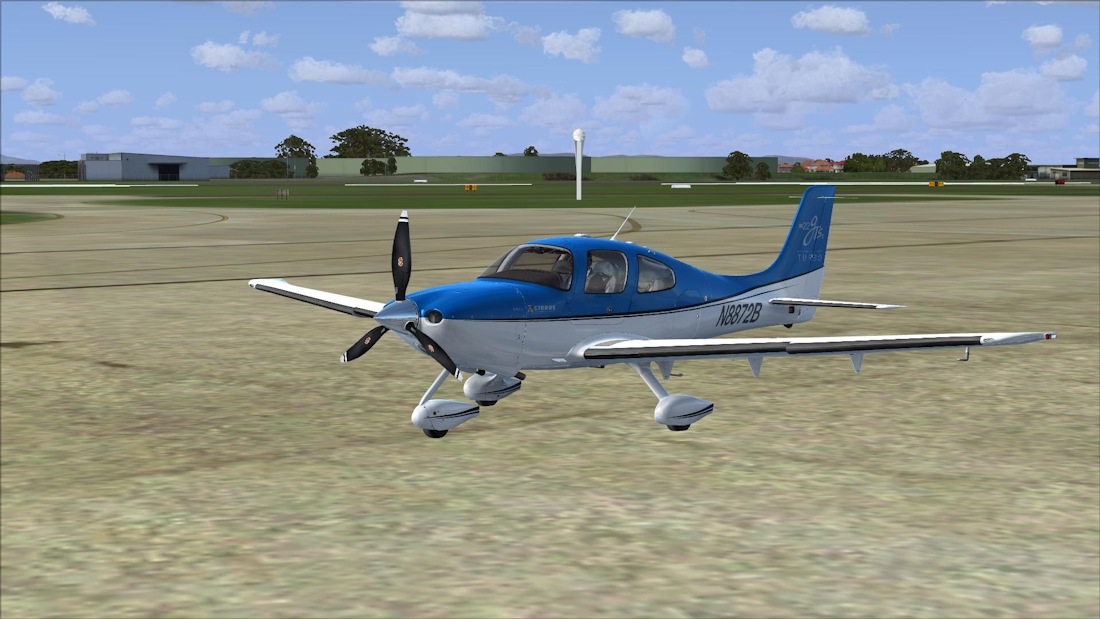 Paint Scheme 1 |
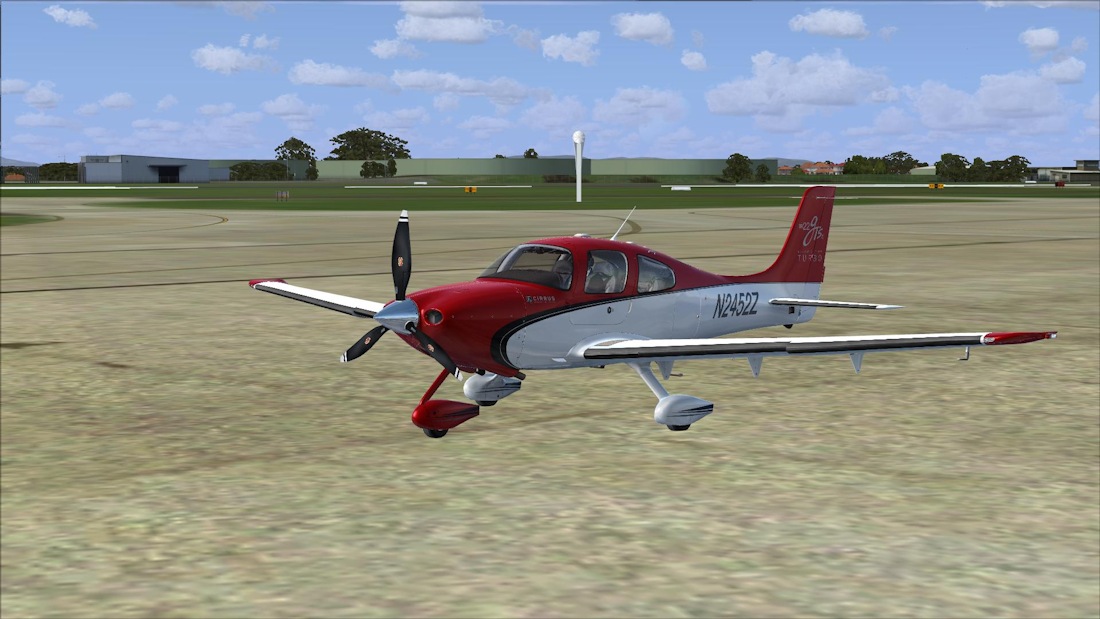 Paint Scheme 2 |
 Paint Scheme 3 |
 Paint Scheme 4 |
 Paint Scheme 5 |
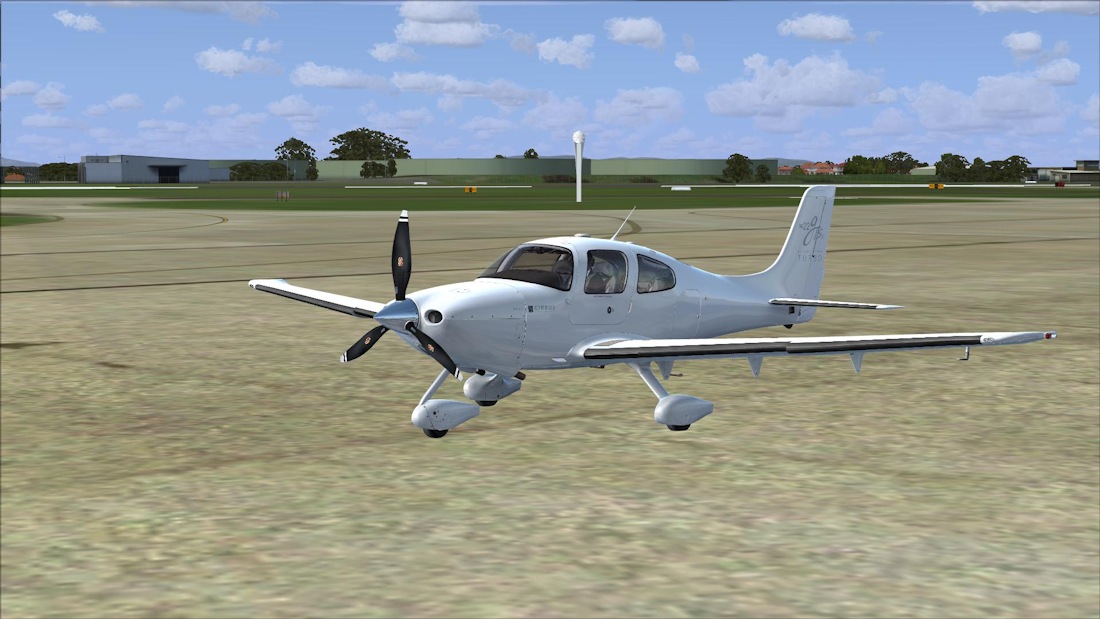 Paint Scheme 6 |
Exterior. Carenado’s Cirrus SR22 GTSx Turbo displays the incredible level of attention to accuracy and detail that has somewhat become an expectation with each new Carenado release. A comparative review of photographs of real world aircraft to Carenado’s SR22 reveal the exterior shape and dimensions to be highly accurate and a true representation of the real world aircraft. Some minor variations where noticed and these appear to relate to the subtle differences between Generation 3 and Generation 5 versions of the aircraft. These variations, in no way, detract from the model.
Interior. Consistent with the exterior, the general appearance of the cockpit and the panel layout are also modelled to a very high degree of detail. A comparative review of photographs of real world aircraft matched the panel layout modelled by Carenado.
Paint Schemes. There are five individual paint schemes and each aircraft has a unique aircraft registration number. The surface textures, reflections, and shadings give the aircraft an unbelievably realistic appearance.
Exterior
Like other aircraft in the Carenado range, the Cirrus SR22 GTSx displays the hallmark accuracy and detail on the exterior. The level of this detail includes individual fuselage panels, panel access screws, grab handles on each side of the fuselage above the rear window, various aerials and antenna, and a tie down point underneath the empennage. The wheel pants are also modelled in high detail with access panels for the tyre inflation valves.
 External Front |
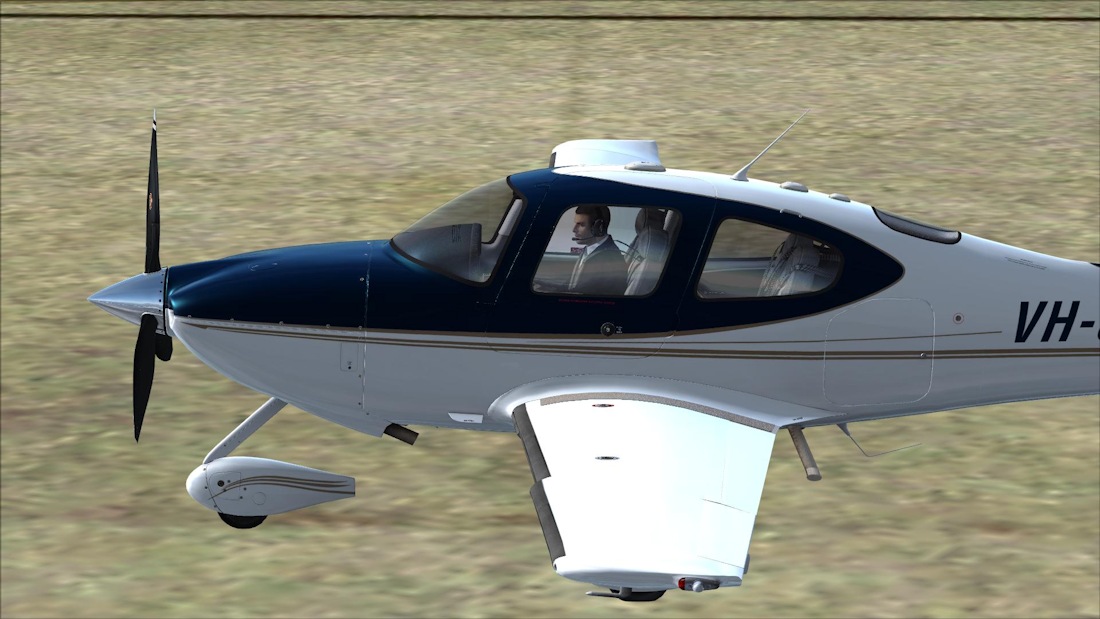 External Side |
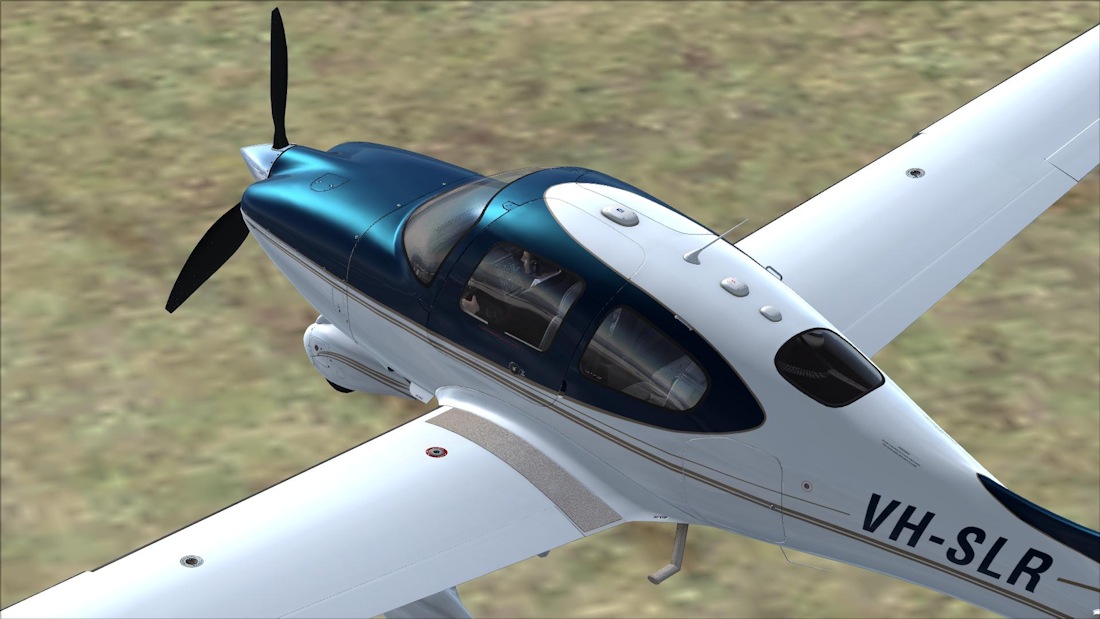 External Top |
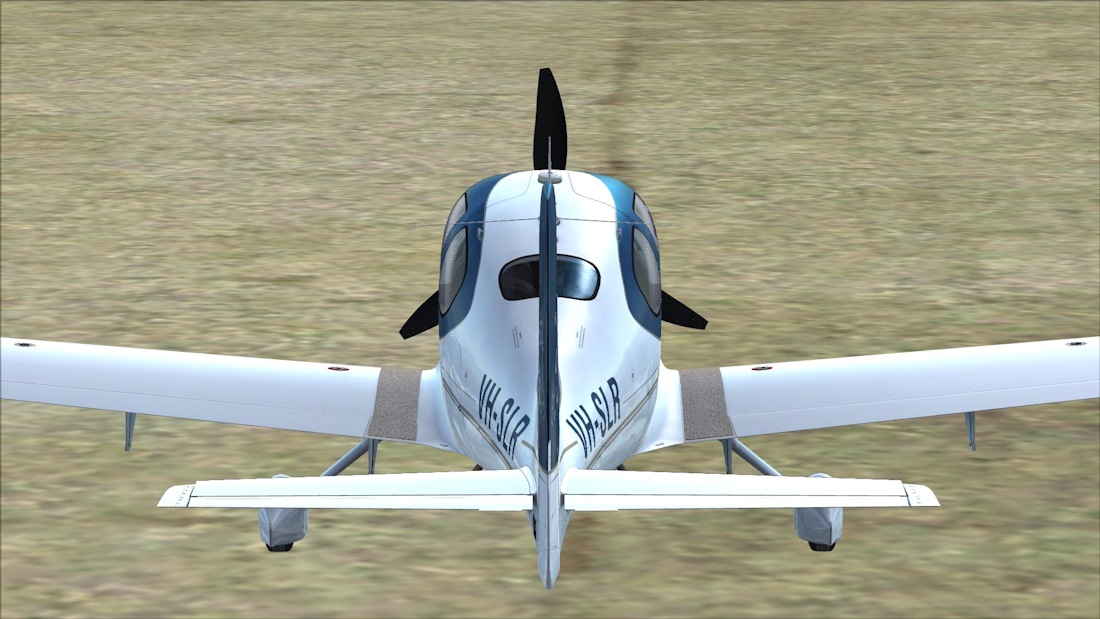 External Rear |
Carenado’s rendering of the SR22’s cockpit is excellent and very realistic when compared to real world layouts. One new feature is the window lighting scratches effect (crazing) on the windshield. This might take some getting use to initially, however, it adds further to the accuracy and realism Carenado are trying to achieve.
Instruments and Panel Layout. The layout of the interior very much resembles that of a modern luxury car. The PFD is located on the left side (pilot side) with the MFD located centrally and angled towards the pilot. The GFC 700 Control Unit, with autopilot and ADF radio are located in a centre console configuration below the MFD, and the throttle and fuel controls are located in a console, centrally between the front seats. The flight instruments are extremely clear and easy to read and have the option for instrument glass reflections to be enabled or disabled. The SR22 does not have a traditional yoke, instead it uses a joystick control with these being mounted on the extreme left and right sides of the cockpit panel respectively. The autopilot master switch and aileron and elevator trim control are located on the joystick. The PFD and MFD, whilst being discrete, also have some degree of duplication in functions and can be configured for a variety of different displays of information. This is covered quite well in the documentation. The PFD, MFD and GFC 700 Control Unit are also available as panel windows. Various alternative cockpit camera views are available to provide a more detailed view of the instruments and the cockpit in general. Unfortunately, no checklists or aircraft reference data is provided on the 'Kneeboard'.
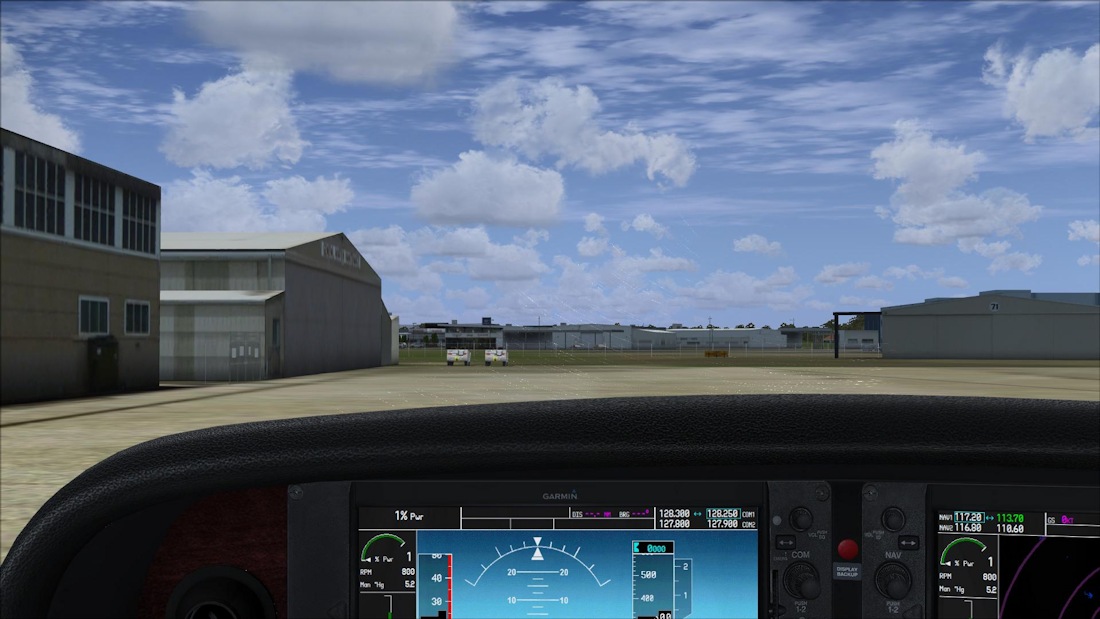 Internal Pilot View |
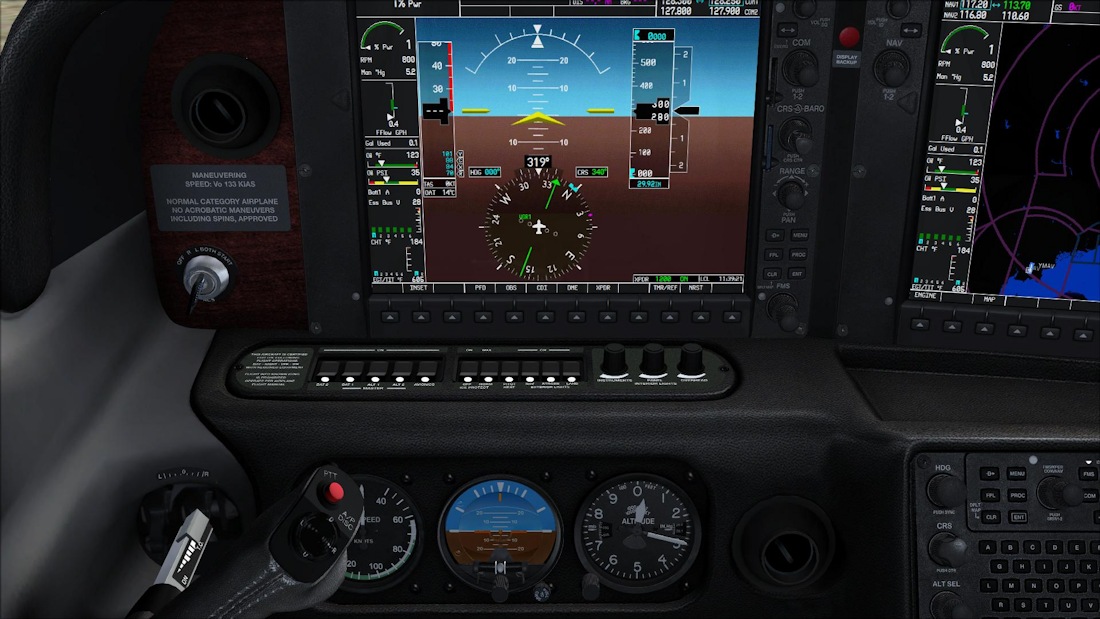 Internal Left Panel |
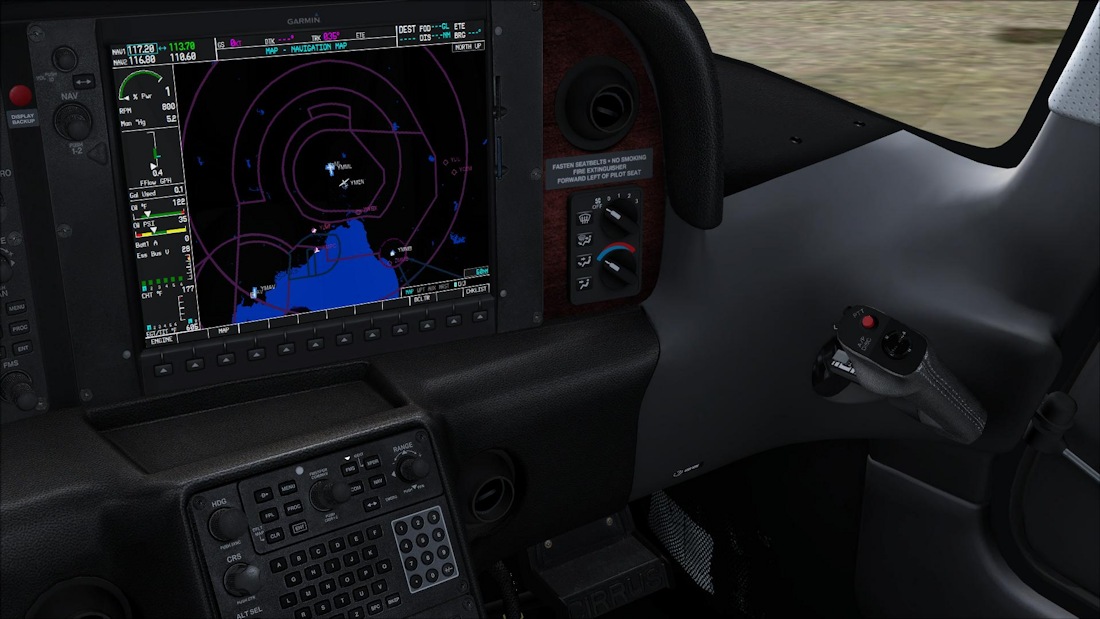 Internal Right Panel |
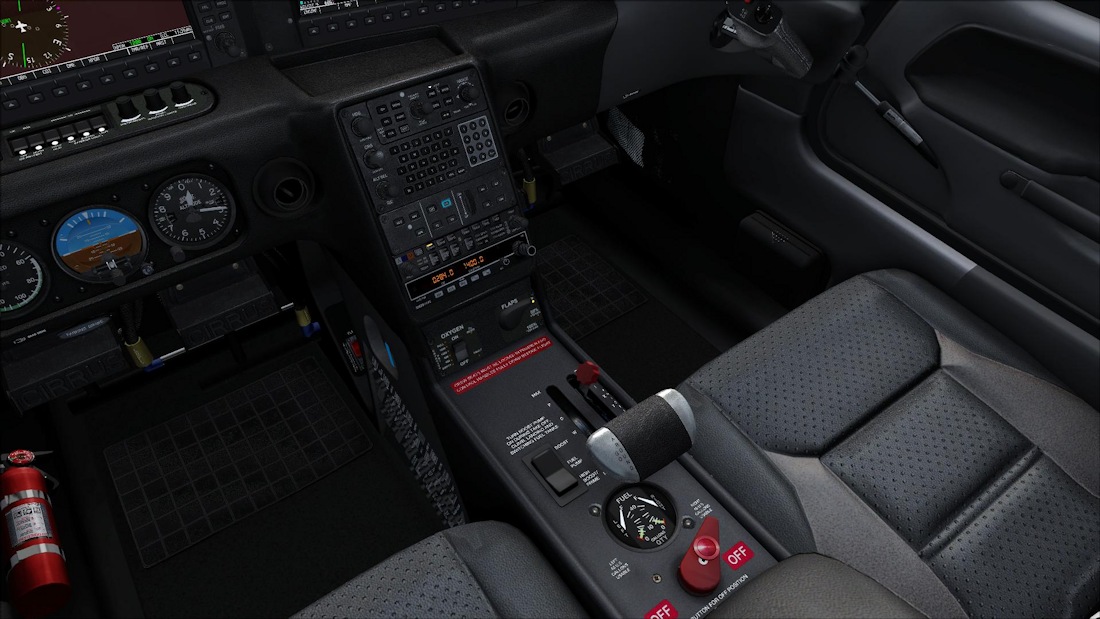 Internal Centre Console |
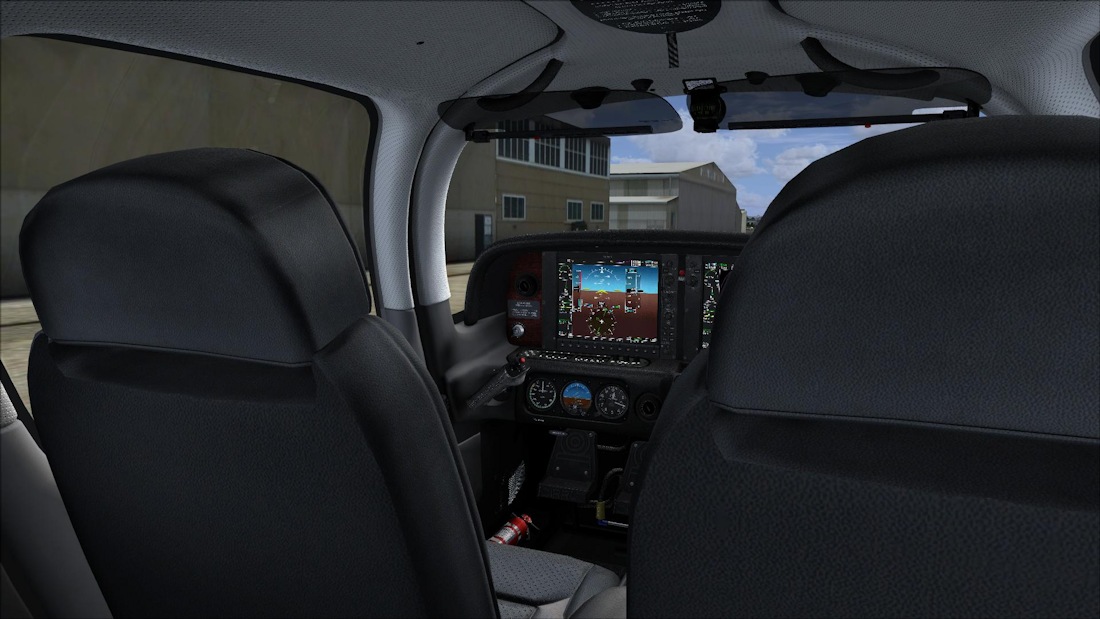 Internal Rear Passenger |
 Internal Cockpit |
Animations and Static Elements
The animations and moving parts on Carenado’s SR22 are all modelled faithfully.
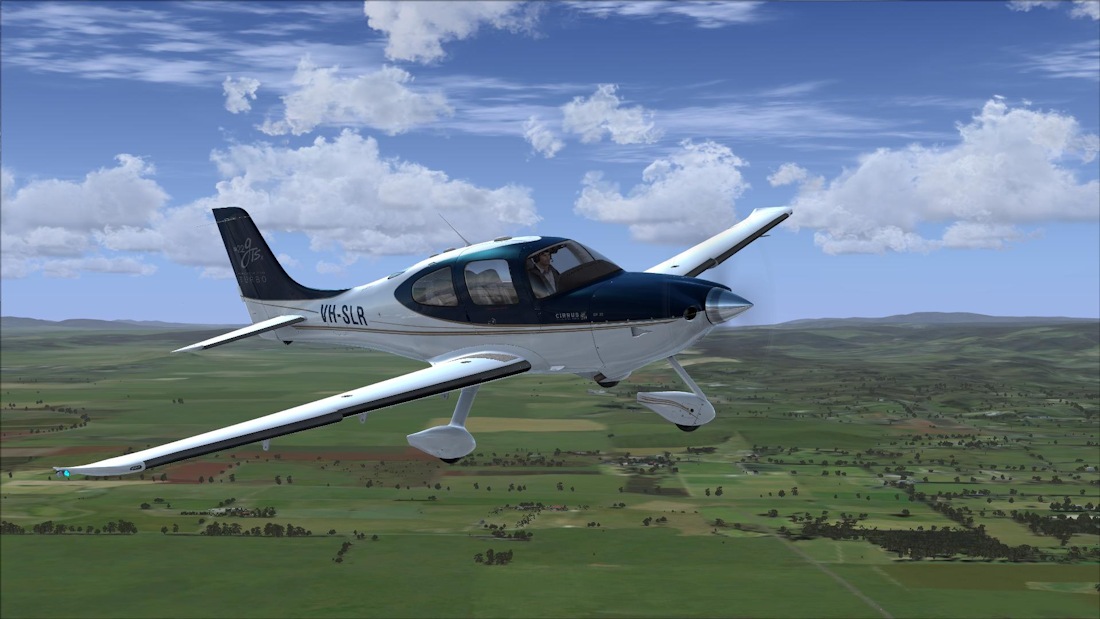 In Flight |
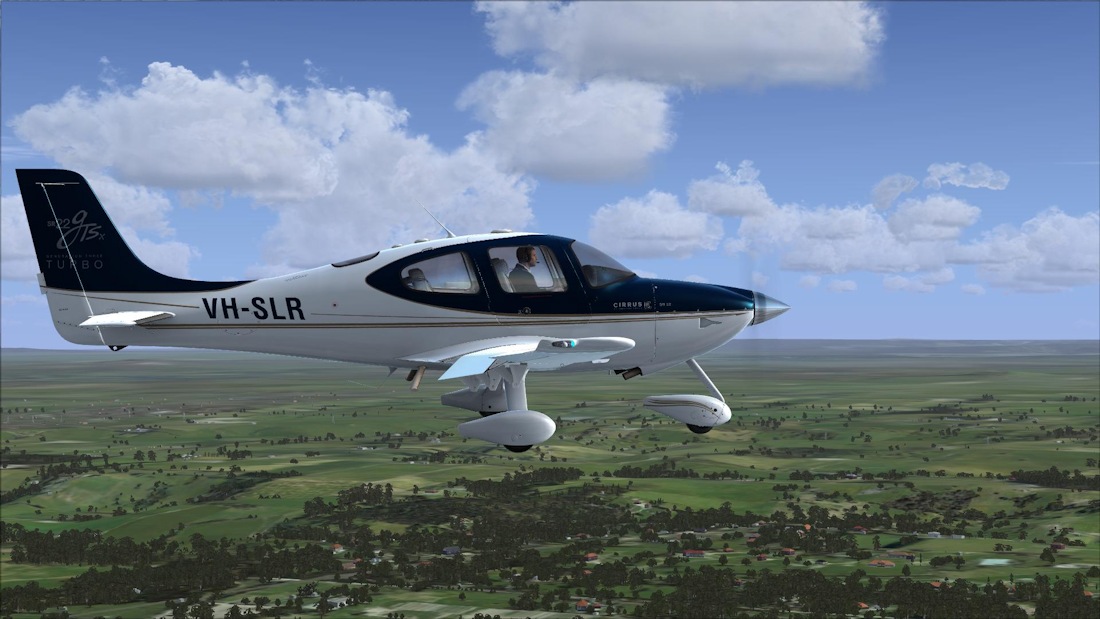 Landing Configuration Side |
Animations and static elements include:
● Primary control surfaces – ailerons, elevators and rudder;
● Secondary control surfaces – flaps;
● Others – rolling wheels, cockpit doors open / close, luggage compartment door open / close, sun visor, and vibrating exhaust;
● Pilot’s head turning; and
● Engine air inlet covers, pitot tube cover and safety cones.
 Ground External Front |
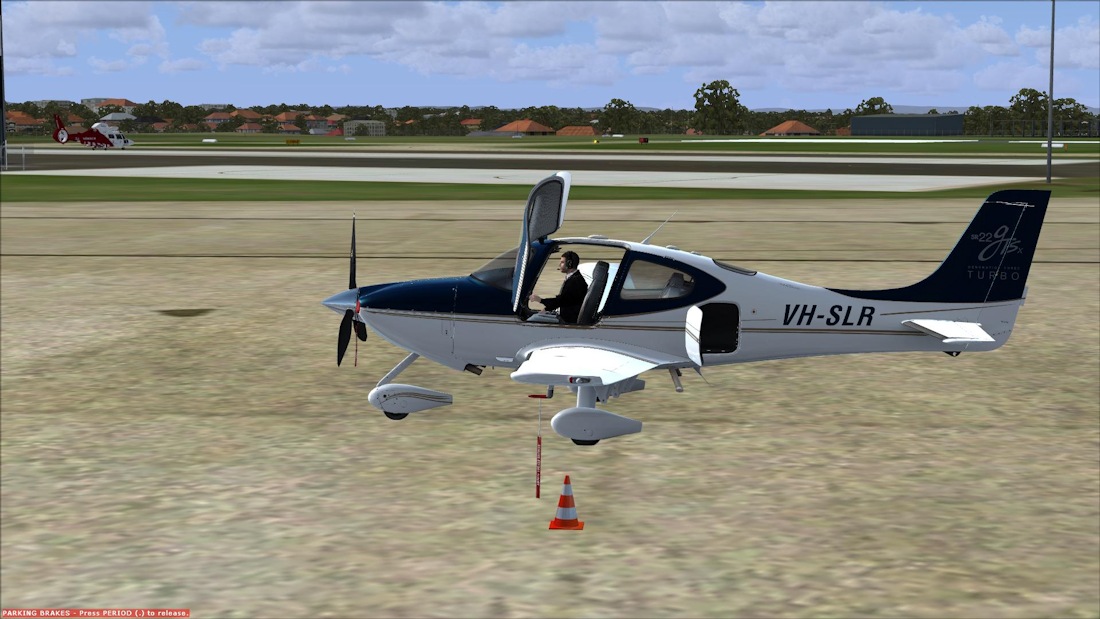 Ground External Side |
The lighting effects on Carenado's SR22 incorporate new light technology which provides an improved lighting effect over previous products. In addition to the usual navigation lights, rotating beacon, strobe light, and landing light effects, the instrument panel has a night red light feature. Of particular note is the strobe light effect, which replicates the true asynchronous flash effect of these lights. The detailed night light effects for the instrument panel and the cockpit, generally, are quite exceptional and represent the night lighting seen in photographs of real world aircraft. All interior lighting affects can be seen when viewing the aircraft from an external view.
.jpg) Internal Pilot View (night) |
.jpg) Internal Left Panel (night) |
.jpg) Internal Right Panel (night) |
.jpg) Internal Centre Console (night) |
A highlighted feature of Carenado’s SR22 is the original HQ digital stereo sounds recorded directly from the real aircraft. The engine exhibits a deep throaty rumble on start before settling into a steady burble sound during idle. As the throttle is increased for take-off, the engine quickly adopts strong steady 'thrum' that then settles to a 'humming' sound as the aircraft is configured at cruise. The stereo quality is excellent and so lifelike as you swivel the head position in the cockpit.
Other realistic sounds include the knobs and switch sounds and there is also the usual sounds associated with the doors opening and closing. When viewing the aircraft from the 'Outside Spot View' and directly behind the aircraft there is also a very realistic wind rush sound.
General Characteristics and Performance Specifications
The general characteristics and performance specifications for the Cirrus SR22 GTSx Turbo are provided in the table. This is based on data from the Cirrus web site, data in the aircraft details provided by Carenado, and general research sources. Some of this data varies between sources and also may be an approximation due to variances in data and the specific aircraft modelled by Carenado.
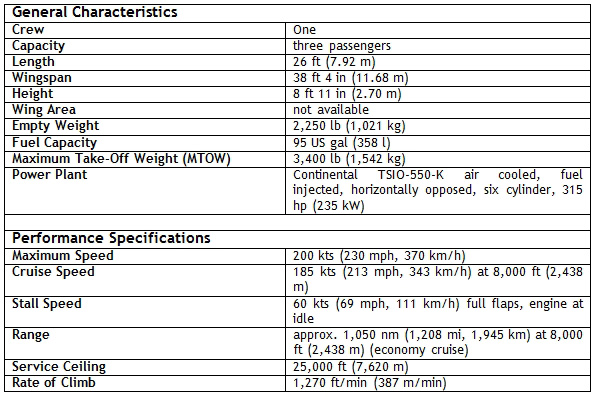 |
Flight Performance
Two Test Flights were conducted from Essendon (YMEN) to Hamilton Island (YBHM) and return. Both flights were conducted in clear weather with a full load of fuel and the aircraft at maximum take-off weight (MTOW) and the route distance was approximately 1064 nm. The route was particularly chosen to provide a basis upon which to test the range characteristics of Carenado’s SR22. Like most aircraft of this type, adjustments must be made to fuel / pax loading to remain within the MTOW limitations.
On the first Test Flight, a cruise altitude of 7,500 feet was adopted. With 50% flaps, aircraft rotation occurred at 70 to 75 KIAS and the aircraft easily maintained an initial climb speed of approximately 130 KIAS at a rate of climb of 800 ft/min. Even at MTOW, the SR22 climbed effortlessly to the cruise altitude and within the specified rate of climb and speed performance parameters for the aircraft. During cruise, an economy setting of 60% power was established with manifold and rpm settings of 26.1 in Hg and 2500 rpm respectively. The mixture setting was leaned out to produce a fuel flow rate of approximately 12.0 gph. Configured for landing, with full flaps and trimmed for a descent rate of approximately 500 ft/min, the aircraft’s approach speed was 90 to 95 KIAS and it touched down at approximately 85 KIAS, with a landing roll out comparable with the specifications for the SR22. The cruise settings produced an average ground speed of approximately 159 knots for the flight and on shut down on the ramp at YBHM, there was 12.1 gallons of fuel remaining in the tanks.
For the second Test Flight, the aircraft was operated at the service ceiling altitude of 25,000 feet. Again, and with the obviously required adjustments to the rate of climb, the aircraft was able to climb to this altitude with relative ease. During cruise, an economy setting of 60% power was established with manifold and rpm settings of 24.1 in Hg at 2500 rpm respectively. The mixture setting was leaned out to produce a fuel flow rate of approximately 13.5 gph. This produced an average ground speed of approximately 193 knots for the flight and on shut down on the ramp at YMEN, there was 19.2 gallons of fuel remaining in the tanks. These Test Flights confirm the modelling of the aircraft for range performance to be very accurate.
The real world aircraft does not have nose wheel steering as the nose wheel is free castoring and uses differential braking on the main gear to steer. This is modelled in Carenado's SR22, and while differential braking can make steering tricky for the inexperienced, with practice, the aircraft is easy to taxi and relatively easy to steer, but it does need some careful control as speed increases during the take-off roll.
The Cirrus SR22 GTSx Turbo is a slick aircraft in flight. In all, the aircraft performed excellently during all phases of flight and the aircraft model displays a very accurate rendition of the flight characteristics and performance of the real world aircraft. Carenado claim the aircraft has been tested by real world SR22 pilots and provided testimonials claim a high degree of accuracy in the flight characteristics. Some close attention to speed is required during the descent and during preparations for the approach, otherwise, you will find yourself in trouble with your speed being too high at the wrong times, resulting in being too fast during the approach and causing you to land long and / or with an extended landing roll.
Technical Requirements
The Carenado Cirrus SR22 GTSx Turbo is for FSX / P3D only. Other specified technical requirements are as follows:
● Windows XP with SP3 installed, Windows Vista or Windows 7 (32 or 64 bit);
● Microsoft Flight Simulator FSX with SP1 and SP2 (or Acceleration Pack) or Lockheed Martin Prepar3d Flight Simulator installed; and
● Pentium V, 3GHz or similar, minimum 2GB RAM (4GB recommended), 512MB graphics card, and 380MB available HDD space.
Simulator Performance
The aircraft model performed very well within the existing settings I have in FSX. I have most of my settings set very high and there was no need to make any adjustments. FSX continued to perform smoothly and as it would with any default aircraft.
Review Computer Specifications
The specifications of the computer on which the review was conducted are as follows:
● Intel i7 990X Extreme 3.46GHz;
● NVidia GTX580, 1536MB graphics;
● 12GB Kingston DDR3 2000MHz;
● Windows 7, (64bit);
● Microsoft Flight Simulator FSX Acceleration; and
● + Additional major add-ons include Orbx FTX Australia and Ultimate Traffic 2.
Conclusion
Carenado’s Cirrus SR22 GTSx Turbo oozes excellence, finesse and quality. Whilst it doesn't have the artistic, sleek, sporty lines of the Lancair Legacy, it exudes luxury and performance and is one of the classic luxury aircraft of the general aviation category and is a pleasure to fly. If general aviation aircraft are your preference, you will enjoy having this aircraft as an addition to your hangar.
The Cirrus SR22 GTSx Turbo is another solid product from Carenado that displays the usual high quality and attention to detail and represents very good value for money.
Pros:
● High quality and attention to detail;
● Excellent animations and sound effects;
● Realistic modelling and performance;
● Excellent user manual, normal procedures and emergency procedures documentation; and
● Very good value for money.
Cons:
● No major cons found.
| Verdict: |
 |
|
| • External Model: | 9.5/10 | |
| • Internal Model: | 8.5/10 | |
| • Sounds: | 10/10 | |
| • Flight Characteristics (does it fly by the numbers): | 10/10 | |
| • Flight Dynamics (does it feel like what it looks like): | 9.5/10 | |
| • Documentation: | 9.0/10 | |
| • Value for money: | 9.0/10 |
| Mutley’s Hangar score of 9.4/10, "Highly Recommended" and a Mutley's Hangar Silver Award. |
